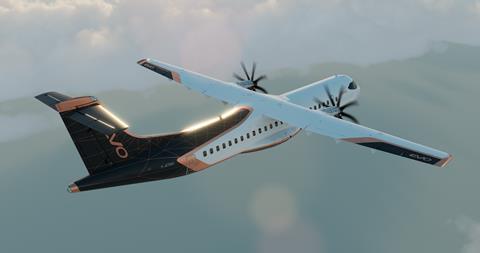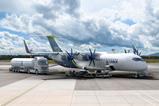ATR and Pratt & Whitney Canada will investigate a “mild hybrid” version of PW127XT engine for the airframer’s proposed Evo upgrade of its regional turboprop, augmenting an enhanced version of the powerplant with a 200kW electrical motor connected to the reduction gearbox.
Such a parallel hybrid architecture would contribute up to 10% of the 2MW (2,750shp) peak output required from each powerplant, says ATR senior vice-president of engineering Daniel Cuchet, assisting the thermal engine in “some specific spaces”, particularly “take-off and top of climb”.
In turn, this would allow the turboprop engine to be optimised for a lower power rating, boosting its efficiency.

Cuchet spoke to FlightGlobal at the Paris air show, providing more details on the collaboration agreement with long-term propulsion supplier P&WC disclosed at the event.
Encompassing “the development of advanced propulsion technology for regional turboprop aircraft”, the work will allow ATR to build towards a launch decision for the Evo towards the end of the decade, supporting a revised service-entry goal of around 2035.
Cuchet says the manufacturer is targeting a “double-digit” reduction in specific fuel burn from the thermal engine “with the ambition to push this as far as technically feasible and to explore the disruptive potential of hybrid-electric propulsion”.
In parallel, additional improvements in aerodynamic and propeller efficiency will contribute to overall aircraft-level fuel burn reduction and operating cost savings.
ATR has previously said it was seeking an overall fuel-burn reduction of 20% from the Evo.
“All this we do as a complete package for feeding the Evo and this is what we are studying today with Pratt and also internally to ATR,” he says.
Although it will be the hybridisation that grabs the headlines, Cuchet says incorporating it into the current powertrain will require an “adaptation” of existing technology rather than development and maturation of an all-new concept.
It becomes, he says, about “integration of the mild hybridisation at aircraft level”.
That task will be made simpler by the compact motors envisaged, offering “a really efficient volume for 200kW”. However, batteries and inverters will also be required.
But in addition to the hybridisation, P&WC will also look to wring more performance from the gas turbine’s hot section, incorporating new materials to allow higher-temperature operation and improved internal aerodynamics, addressing “the parts not touched by the XT [upgrade]”.

P&WC introduced the XT variant of the PW127 in late 2022, cutting fuel burn by 3% and slashing maintenance costs by 20% over the engine’s previous iteration. Changes included new low- and high-pressure compressors and high-pressure turbine module.
While ATR’s next step envisages a significantly larger efficiency gain, Cuchet notes that lower maintenance costs were the main goal of the XT upgrade, not a sizeable fuel-burn reduction.
“What we want to do for our next-generation thermal engine is maintain the improvement on the maintenance cost but to focus also on the fuel burn, this time at a higher level,” he says.
Flight tests of the improved engine towards the end of the decade form part of its strategy, potentially taking place through the EU’s Clean Aviation initiative.
Cuchet says the airframer has responded to the body’s third call for proposals – the start of its second phase – but gives few details on its submission.
ATR has been working as part of a Rolls-Royce-led consortium in Clean Aviation’s first phase, as part of a project called HE-ART that runs until December this year.
Although ATR says it remains committed to the HE-ART consortium until the project’s conclusion next year, given the alliance with P&WC, it is unclear whether that also applies to Clean Aviation’s second phase.
P&WC and sister RTX company Collins Aerospace have also been working through a Canadian government-funded project to hybridise a De Havilland Canada Dash 8-100 and Cuchet says he “envisages” ATR benefitting from the technologies being developed through that effort.
“I cannot answer more today because it’s under discussion the things we rely on. It’s not a secret per se it’s just that we are discussing together to find the right [path],” he says.
But whereas the Canadian project features an all-new thermal engine, this is “not what we want to achieve”, says Cuchet.
“We want to use the current engine that we have improved. We want to keep our engine principle of course and enhance it with mild hybridisation.”
































